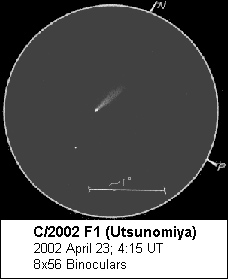April 23, 2002
My yard has trees to the west, so I am not able to see Mercury in the current planetary alignment. I felt that a clear night called for a road trip by foot, to Spink's Community Park on the edge of my town of Chiloquin. The park has some glaring lights to the east, but to the west it is relatively dark and there are some gaps in the tall pine. I wasn't really concerned with darkness anyway, especially with a bright Moon in the sky. I just wanted a low horizon. I left home at about 8:30pm.
Even as I walked along the road, I could see Mercury, completing the string of five planets. Jupiter stood high and bright in Gemini. Steady Saturn sat near twinkling Aldebaran. Below them, faint Mars was slightly out of alignment with the rest. Dazzling Venus dominated the scene, and Mercury sat near the horizon. But, wait, a sixth planet was easily visible below my feet. It seemed appropriate to recognize this fact, on Earth Day. The waxing gibbous Moon watched over all of this from a perch in Leo. Sure, this alignment has been over-hyped in the media, but it is worth a walk.
During the course of my travels, the sheriff's deputy pulled up and asked me why I was walking around at night with a pair of binoculars. When I told him I was watching a planetary alignment, he replied, "Right on!"
I got to the park at around 8:45pm, and took a good look at each of the planets through those suspicious binoculars. Mercury was yellow-orange and shimmering, about to be occulted by a cell phone tower on Steiger Butte. Venus was glaringly white. Mars revealed its trademark reddish-orange hue. Saturn's oval shape showed well, as did its warm yellow hue. Two of Jupiter's moons, Ganymede and Callisto, were easily visible. Io and Europa were hidden in the planet's glare, but probably would have popped out if I had really tried to see them. The brilliant Moon revealed its cratered surface.
Aside from the planets, I planned to try to observe Comet C/2002 F1 (Utsunomiya). Hidden in the twilight glare throughout its apparition, this comet would be a difficult target. I got a very brief glimpse in morning twilight a few days ago, but figured the comet's current position would favor evening viewing. I hopped with my binoculars from the star Gamma Andromedae, and soon found my guide stars, Beta and Gamma Trianguli. At first, the comet was not visible, but as the sky darkened a pale white sliver appeared. Minute by minute, the comet revealed more detail until it became a scarcely elongated, starlike head with a narrow tail. The tail extended for half a degree, then faded abruptly. I judged the comet's out-of-focus brightness to be nearly equal to Delta Trianguli at magnitude 4.8. The comet remained visible in binoculars until after 9:30pm, although it began to fade as it sank into the murk.
While I was at it, I figured I should view Ikeya-Zhang, the more famous and accessible comet that has appeared in the news recently. It was rather low in the northern sky, but easily visible nonetheless. Ikeya-Zhang, so impressive two weeks ago, is now a fuzzball. It is still visible to the naked eye at magnitude 4.3, and in binoculars looks much like a brighter version of the globular cluster M13. Due to the moonlight interference and the comet's fading, only a very faint stub of a tail was visible in the binoculars.
Six planets, two comets and the Moon. Neighbors in a vast universe; only a chosen few have left the protective atmosphere of our home planet, but the cosmos is accessible to all who look up. Repeat until satiated.


